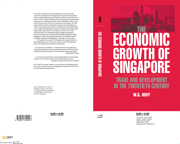Book contents
- Frontmatter
- Contents
- List of figures
- List of tables
- Preface and acknowledgements
- Abbreviations and conventions
- Geographical definitions
- Introduction
- Part One Themes and beginnings
- Part Two Development as a staple port, 1900–1939
- 3 Trade, finance and development
- 4 Ocean-going shipping, the port and regional transport
- 5 Immigration, population and employment
- 6 Rubber: boom and spread of a twentieth-century staple
- 7 Rubber, industrialization and the development of Chinese banking
- 8 Petroleum and tin: the twentieth-century boom commodity and a staple in decline
- 9 The distribution of manufactured imports
- Part Three Staple port and rapid growth, 1947–1990
- 12 Conclusion
- Appendix tables
- Bibliography
- Index
7 - Rubber, industrialization and the development of Chinese banking
Published online by Cambridge University Press: 22 September 2009
- Frontmatter
- Contents
- List of figures
- List of tables
- Preface and acknowledgements
- Abbreviations and conventions
- Geographical definitions
- Introduction
- Part One Themes and beginnings
- Part Two Development as a staple port, 1900–1939
- 3 Trade, finance and development
- 4 Ocean-going shipping, the port and regional transport
- 5 Immigration, population and employment
- 6 Rubber: boom and spread of a twentieth-century staple
- 7 Rubber, industrialization and the development of Chinese banking
- 8 Petroleum and tin: the twentieth-century boom commodity and a staple in decline
- 9 The distribution of manufactured imports
- Part Three Staple port and rapid growth, 1947–1990
- 12 Conclusion
- Appendix tables
- Bibliography
- Index
Summary
Singapore was in no way an industrial city. Unlike Bombay or Shanghai, with industries serving large hinterland markets, it did not develop as a major manufacturing centre for Malaya, and certainly not for Netherlands India. At the end of the 1930s, first-stage import substitution, involving a replacement of non-durable consumer goods, remained incomplete. Nevertheless, in the inter-war period Singapore acquired a substantial amount of industry. As the present chapter shows, rubber largely formed the basis for this industrialization.
Primary commodity exports often directly create opportunities for industry, in addition to making an indirect contribution to industrialization through increasing local and hinterland incomes and thus stimulating import substitution. The direct contribution of rubber involved all three possible paths to industrialization. First, rubber milling became by far Singapore's largest primary commodity processing industry. Second, rubber had important backward linkages in the development of import-substituting industries which made capital equipment for the commodity's production. Third, manufacturing for export emerged, since rubber's availability as a raw material led to the export of rubber goods outside Singapore's hinterland. The pattern and timing of industrialization examined in this chapter's first section.
At the same time, rubber encouraged the development of domestic (i.e. Singapore-based) manufacturing by promoting the emergence of entre-preneurs and by putting profits in their hands. In Singapore, Europeans showed relatively little interest in investing in manufacturing, and the agency houses almost none. This opportunity mainly attracted the city's Chinese.
- Type
- Chapter
- Information
- The Economic Growth of SingaporeTrade and Development in the Twentieth Century, pp. 208 - 235Publisher: Cambridge University PressPrint publication year: 1994



